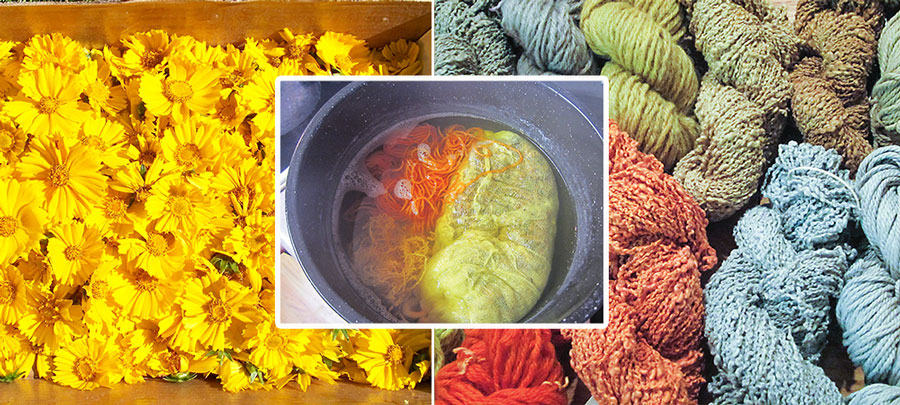
I was working in my asparagus patch, trying to pull a pokeweed, when its stem snapped … and I toppled. I grumbled, “Good-for-nothin’ weed!”
Having heard me, my daughter Sarah retorted, “And this from a biology teacher who lectures about the interconnectedness of all living things?”
Thus began a summer-long artistic endeavor designed to disprove the derogatory phrase “good-for-nothin’ weed.” We started with mullein, a non-native plant with large wooly leaves. Mullein is a roadside weed – I mean to say plant – which sports yellow flowers arranged on a club-like head at the apex of a four-foot-tall stalk. Sarah had read that a dye could be derived from mullein, so we gathered a bushel of leaves and laid them out to dry on an old window screen.
Sarah was able to coerce me into participating in the creation of natural dyes for fiber art. She promised me that I’d enjoy the process because it could be accomplished mostly outdoors. However, I soon found myself standing at the kitchen sink, washing skeins of dye-free non-synthetic yarn in a solution of water and borax. Remembering the old-time soap brand 20 Mule Team Borax, I sang the jingle in my best cowboy intonations.
Laughing, Sarah prepared the mordant necessary to fix the dye so the color wouldn’t wash out. She made a solution of alum, much less toxic than the metallic salts often used. Small bundles of my clean yarn were immersed in the hot solution and simmered in a big enamel-coated pot. When all the bundles had been processed and arranged on a drying rack to air in the afternoon heat, we decided to immerse ourselves in cool water at our favorite swimming hole. We had a pleasant time, lollygagging in the pond. We emerged convinced that algal pond scum would serve as dye, albeit of questionable color.
The next morning, I walked into a steamy kitchen and saw Sarah brewing tea by the gallons, or so it seemed. Steeping in the hot water was a plump gauze bag filled with mullein leaf fragments. As Sarah lowered the yarn into the dye bath and swirled it with a wooden dowel rod, she said, “Mom, help me watch this pot? If it boils, the wool fibers might be damaged.”
Mousy yellow, that’s how I would describe the end result. Not pretty!
We were disappointed, but not discouraged. We kept on experimenting. We gathered Queen Anne’s lace and produced a pale green dye. We braved the chiggers and picked blackberries, staining our fingertips purple but dyeing cloth gray. Dye from pokeweed berries was a dud.
Then, one afternoon in July, we unexpectedly discovered the plant which gave us a beautiful color. I had heard one of our cows bawling, expressing maternal concern of the bovine kind. Sarah and I went in search of the errant calf. We spotted it contentedly lying in the shade of the big burr oak tree on the wrong side of the fence. We crossed the fence and made our way through the tall prairie grasses. The calf got up, found the spot in the fence where it had squeezed through, and trotted over to its mother. Sarah and I ambled back through the prairie, picking wildflowers as we went.
Tickseed or lance-leaved coreopsis is a native prairie plant with daisy-like flowers of eight rays encircling a center of numerous florets. The lovely yellow of this wildflower is less golden than that of Black-eyed Susans but is more vibrant than dandelion yellow. When silk fabric is tinted by the dye derived from coreopsis, the color is dazzling!
For more information about natural dyes, visit www.sarahmarjanovic.com.
Editor’s note: The Sarah Marjanovic website is under construction at the moment, please check back later.









